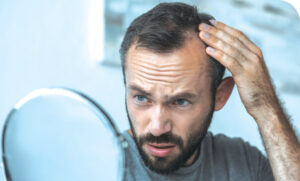By Alan J. Bauman, MD, ABHRS
 August is National Hair Loss Awareness Month, which means it is a great time to become aware of, and educated about, the many tools and treatments available to help the 80 million Americans suffering from unwanted hair loss.
August is National Hair Loss Awareness Month, which means it is a great time to become aware of, and educated about, the many tools and treatments available to help the 80 million Americans suffering from unwanted hair loss.
“Biohacking,” or DIY biology as it is often referred to, is the use of science and biology to quantitatively evaluate, take control of, and upgrade your body, your mind, and your life. Biohacking is being used in countless areas of medicine and is providing some game-changing results, including hair restoration.
Successful hair restoration begins with data-driven biohacking methodology that is used to diagnose and track hair loss in its earliest stages, before it is even noticeable to the naked eye, when you have the best chance of slowing, stopping, or even reversing the progression of hair loss.
“Biohacking” Tools
With the help of an advanced and highly sensitive scientific measurement tool known as HairCheck®, hair restoration physicians can now accurately help you determine the amount and quality of hair growing in a given area of the scalp. This is an effective way to gauge the severity of your hair loss early on, and how well you are responding to restorative treatments in the critical time before the results are noticeable to the naked eye. Another breakthrough tool that is helping assess and diagnose hair loss are hand-held HairCam™ scalp microscopes with special dual-polarized LED lighting that can detect miniaturized hairs vs. areas of depleted density as well as help diagnose rare hair loss conditions and other scalp problems.
These advanced tools provide unique data that allows you and your hair restoration physician the opportunity to customize a personalized treatment plan that not only avoids unwanted side effects but maximizes effectiveness and provide you with optimal results, based on what your follicles need to grow and be healthy. As with any health condition, each patient has different needs and will respond differently to treatment, so having the ability to gain this insight and data is invaluable when deciding upon or modifying a treatment regimen. Your hair growth will be evaluated and tracked just as if you were in a research study.
A Multi-Therapy Approach
While hair loss is a treatable condition, and there are a variety of effective treatment options available, it’s important for patients to understand that there isn’t a quick fix. Often, as it is in many areas of medicine, “multi-therapy” or a combination of several different treatments, may have the best chance for achieving long-term success depending on the patient’s risk factors, the severity of their condition, and their unique hair restoration goals.
This approach not only focuses on restoring hair that has been lost but also sets up a plan to protect the hair that you have against suffering the same fate. Again, each patient may require a slightly varied treatment regimen, but our experience shows that 90% of patients benefit from this approach. The multi-therapy treatment plan also avoids the patient putting all their eggs in one basket, so to speak, and wasting time and money on treatments that aren’t giving them the results they desire.
When executed properly, hair restoration can be a fantastic, rewarding and life-changing decision that most patients regret not doing sooner.
Depending on the severity and stage of one’s hair loss, the treatment regimen may be simple or more complex. Medical treatments that will synergistically help mitigate hair loss may include a specially-compounded prescription minoxidil solution, Platelet-Rich Plasma (PRP), prostaglandin analogs, low-level laser therapy, and nutritional supplements. In advanced cases, hair transplantation may be the patient’s best strategy for treating hair loss. For transplant patients, a multi-therapy approach may still be recommended to protect the non-transplanted hair follicles from loss.
Here are a few of the exciting cutting-edge treatment options to consider and ask your ABHRS (American Board of Hair Restoration Surgery)-certified Hair Restoration Physician about include:
• Minimally-Invasive, Permanent, No-Linear-Scar Follicular Unit Excision/Extraction (FUE) Hair Transplant using VIP|FUE™, SmartGraft®, NeoGraft®, ARTAS Robotic-Assisted, or other devices.
• PDOgro™ – Implanted Polydioxanone threads for hair growth
• Non-surgical 3D-Printed Hair Systems or Cranial Prostheses
• High-Density Platelet Rich Plasma (HD-PRP) “Vampire” Hair Regrowth Therapy with Extracellular Matrix (ECM)
• Compounded Formula 82M Minoxidil – a more powerful, non-greasy Rogaine alternative
• Compounded Formula 82F Topical Finasteride + Minoxidil – designed to reduce the risk of side-effects from oral finasteride (Propecia).
• Low-Level Laser Therapy – FDA-cleared, drug-free, side-effect-free hair regrowth using powerful physician-only devices such as CapillusRX 312 or the “Turbo” LaserCap devices for at-home use.
• Nutritionals & Nutraceuticals: SuperBiotin, Nutrafol & ViviscalPRO
• Scientific “Scalp Makeover®” – evaluation, diagnosis and treatment regimens for itchy, dry, flaking or oily conditions and other scalp imbalances that can impair healthy hair growth.
• Hair Loss Risk Management – the identification and reduction of medical and lifestyle risk factors that detrimentally impact hair growth.
On a closing note, we also understand that some patients still may not be ready to visit us in person during these uncertain times. This is why we will continue offering Virtual Consults, Virtual Follow-ups, as well as an expanded menu of at-home treatment options – to allow our patients to begin, or continue, their hair restoration journey from the comfort of their own home.
For more information on the causes and treatments for hair loss, or to learn more about “biohacking” baldness, please visit www.baumanmedical.com or call 561-220-3480.
 South Florida Health and Wellness Magazine Health and Wellness Articles
South Florida Health and Wellness Magazine Health and Wellness Articles




